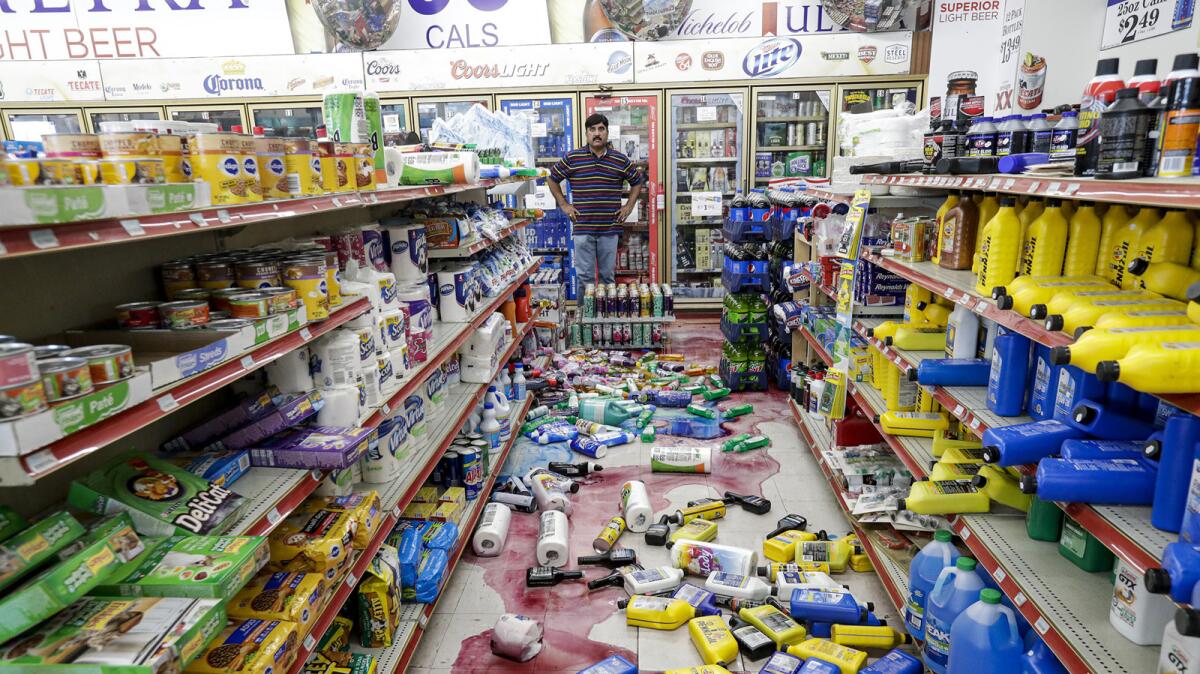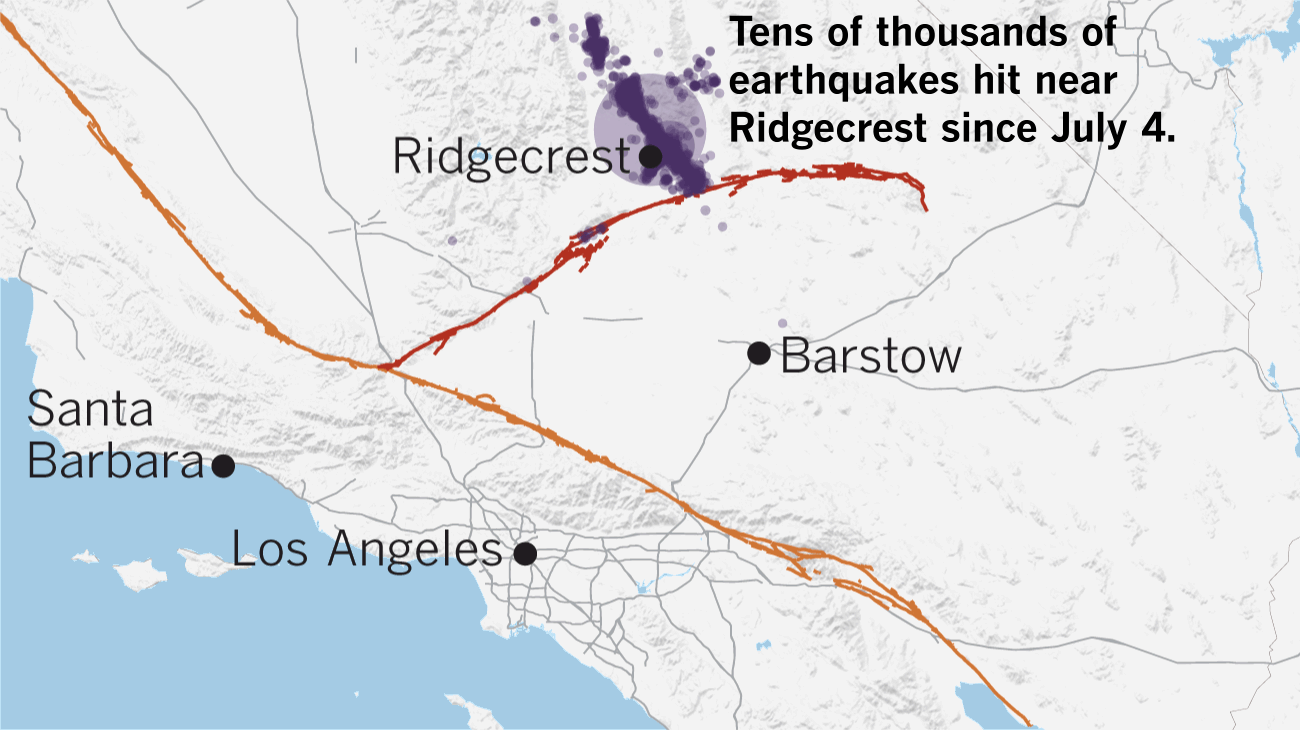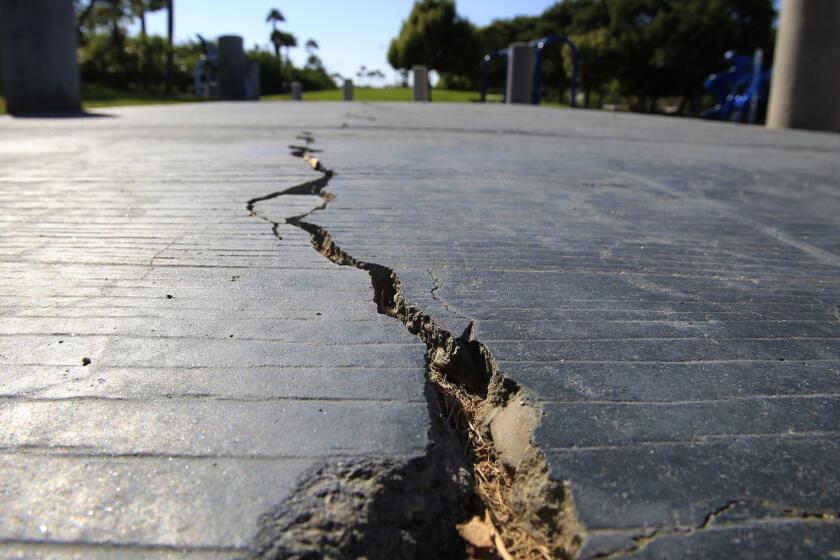Chance of big San Andreas earthquake increased by Ridgecrest temblors, study suggests

- Share via
A new study suggests that last year’s Ridgecrest earthquakes increased the chance of a large earthquake on California’s San Andreas fault.
The study, published in the Bulletin of the Seismological Society of America on Monday, says there is now a 2.3% chance of an earthquake of magnitude 7.5 or greater in the next 12 months on a section of the 160-mile-long Garlock fault, which runs along the northern edge of the Mojave Desert.
That increased likelihood, in turn, would cause there to be a 1.15% chance of a large earthquake on the San Andreas fault in the next year.
Those odds may seem small. But they’re a substantial jump from what the chances were before last year’s Ridgecrest, Calif., earthquakes, whose epicenters were about 125 miles northeast of downtown L.A.
The new odds mean a large quake on the Garlock fault is now calculated to be 100 times more likely — rising from 0.023% in the next year to 2.3%.
And the chance of a large quake on the San Andreas has roughly tripled, from 0.35% in the next year to 1.15%, said Ross Stein, a coauthor of the study and the CEO of Temblor, a catastrophe modeling company in the Bay Area that has built a free earthquake hazards app for smartphones.

Seismologist Lucy Jones, who did not play a role in the report released Monday, called the study “elegant science” but added that its conclusions are not confirmed.
“It’s really interesting science, and I like the way they’ve been able to increase the complexity of how they do their modeling. That’s a real advance. But it’s not yet proven,” Jones said.
That said, Jones said that government officials in California should be prepared for a scenario in which an earthquake occurs that immediately raises the risk of a large quake on the San Andreas fault.
“If the Garlock happens, yes, we will be saying the San Andreas is at increased risk,” Jones said. “What do you do when there’s an earthquake that could be a foreshock to the San Andreas? What do you say? What do you do?”
Scientist knew almost immediately that the Ridgecrest quakes were not on the San Andreas fault. But understanding how those temblors might impact the 730-mile monster capable of producing “The Big One” has been a vital.
The study is the latest suggestion of a plausible scenario in which last summer’s earthquakes in a remote part of California might have started a chain of events that could result in a devastating earthquake on the San Andreas fault that has not been seen in Southern California in 163 years.
At its closest, the San Andreas fault comes within 35 miles of downtown Los Angeles.
“Now, you can think of the Ridgecrest earthquake as being so far from Greater Los Angeles ... that it is nearly harmless,” said Stein, an earthquake scientist emeritus of the U.S. Geological Survey and adjunct professor of geophysics at Stanford University.
“But the problem is that ... the Ridgecrest earthquake brought the Garlock fault closer to rupture. If that fault ruptures — and it gets within about 25 miles of the San Andreas — then there’s a high likelihood, maybe a 50/50 shot, that it would immediately rupture on the San Andreas,” Stein said. Stein’s coauthor on the study is Shinji Toda, of Tohoku University in Japan.
If the Garlock fault did rupture close to the San Andreas fault — but the San Andreas did not immediately rupture — Los Angeles would face the prospect of having a metaphorical sword of Damocles hanging over its neck, Stein said, with the prospect of L.A. facing a larger risk of a San Andreas quake within a matter of months, or perhaps decades.
“In a way, if the fault ruptures all at once, life is simpler. It’s done,” Stein said. “But if it doesn’t — if it hangs, and plenty of faults do hang — that would put the city in a really difficult ... position.”
A hypothetical magnitude 7.8 quake on the San Andreas could cause more than 1,800 deaths, injure 5,000, displace some 500,000 to 1 million people from their homes and hobble the region economically for a generation. A quake of that magnitude produces 45 times more energy than the 1994 magnitude 6.7 Northridge quake.
Out of the many faults in California, the San Andreas is singularly poised to be the one that unleashes a megaquake in our lifetime because it is the main tectonic plate boundary between the Pacific and North American plates, and because of how fast the fault accumulates seismic strain.
Another troubling scenario Jones has mentioned before was a hypothetical magnitude 6 earthquake at the Cajon Pass north of San Bernardino. It’s a particularly vexing scenario because such a quake could trigger large quakes on three major faults: the San Andreas, the San Jacinto and the Cucamonga.
The last time scientists in California warned about an increased risk of a big earthquake on the San Andreas fault, however, the initial statewide response was flatfooted.
In 2016, state officials didn’t issue a statement of the increased threat of a big quake on the San Andreas fault until about 39 hours after the first concerning quake hit in the Salton Sea.
Even when state officials finally put out a statement, they inserted an error that inaccurately downplayed the increased seismic risk. It was corrected after an inquiry from the Los Angeles Times.
California has suffered some destructive earthquakes in the last few decades but much bigger quakes are possible. These maps show some scenarios.
The study published Monday is not the first time scientists have suggested the Ridgecrest earthquakes could be the first domino to fall that eventually leads Southern California’s section of the San Andreas fault to rupture in a significant way for the first time since 1857, when a magnitude 7.8 earthquake ruptured 225 miles of fault between Monterey County and the Cajon Pass in San Bernardino County.
A year ago, the U.S. Geological Survey — the nation’s primary earthquake science agency — calculated that there was an extremely remote chance the San Andreas could be triggered by the Ridgecrest quakes.
And a USC professor of earth sciences, James Dolan, articulated the same Ridgecrest-to-Garlock-to-San Andreas scenario in an interview with The Times last year.
The Garlock fault ruptures on average every 1,300 years, said Tim Dawson, senior engineering geologist with the California Geological Survey, but earthquakes can occur as often as every few hundred years or have a drought between large quakes of as long as 3,000 years. The last big earthquake on the Garlock fault happened about 500 years ago, Dawson said.
Big quakes on the southern San Andreas fault along the Grapevine section of Interstate 5 can happen on average every 100 years, although there’s wide variation in how often they can happen; there has been a time when it was just 20 years between major quakes, and another when there was a gap of 200 years between huge quakes.
Though it’s far from a sure bet the Garlock fault will rupture in our lifetime, the southern San Andreas is a likely candidate for such a big quake in our lifetime. “It’s really the fastest moving fault in California,” Dawson said of the San Andreas, meaning it accumulates strain far faster than other faults. “It’s always going to play the most significant role in earthquake hazard in California.”
Data from seismic sensors in buildings across Southern California show how the 7.1 Ridgecrest earthquake produced surprisingly long periods of shaking in some areas.
There’s a popular conception that earthquakes relieve seismic strain — they do — but they also increase seismic strain in other areas.
“An earthquake will relieve stress on the fault that it occurs on. But by relieving that, you’re transferring the stress onto something else,” Dawson said. “For every action, there’s a reaction.”
Scientists — and the public — have long been fascinated about the prospect of triggered earthquakes. It was a main plot point in the movie “San Andreas,” starring Dwayne Johnson in 2015.
It’s for a good reason.
Last year’s Fourth of July Ridgecrest quake, a magnitude 6.4 temblor, imparted greater stress on a fault that eventually ruptured a day later, causing the more powerful magnitude 7.1 quake on July 5.
The most powerful earthquake in California of the last 68 years, the magnitude 7.3 Landers earthquake that hit the sparsely populated Mojave Desert on June 28, 1992 — and a magnitude 6.3 aftershock hours later near Big Bear — was believed to be related to the Joshua Tree earthquake, a magnitude 6.1 event, that occurred two months earlier.
The trio of quakes raised concerns that the San Andreas was next.
The theory at the time was that the Joshua Tree-Landers-Big Bear sequence of quakes essentially unclamped a section of the San Andreas fault. That made it plausible the San Andreas fault might be next to rupture, said Ken Hudnut, geophysicist with the USGS.
But the southern San Andreas fault has remained as quiet as it has since the 1850s.
Instead, the next big quakes in Southern California occurred where few scientists were expecting them to hit — the magnitude 6.7 earthquake that struck Northridge in 1994, and the magnitude 7.1 Hector Mine earthquake in 1999 that was located even deeper in the remote Mojave Desert.
“What has been actually happening in the real world is quite different than what we thought was a plausible scenario back at the time in ’92,” Hudnut said.
More to Read
Sign up for Essential California
The most important California stories and recommendations in your inbox every morning.
You may occasionally receive promotional content from the Los Angeles Times.














